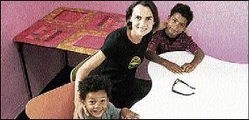Going to preschool for a second and a third language
Published: Monday | June 8, 2009

Aline Luna-Less with her sons at the Centre of Language and Culture.
While preschool is not a necessity, its benefits should not be dismissed. It's a safe environment in which to leave your sons and daughters while you're at work; through play they will be learning; and it generally gives them a good head start for prep school. The question is, which one do you choose?
Preschools like Building Blocks, Rainbowland, Wynter Academy, Kid City and Step by Step are great choices and each child I know who goes to any of these is doing well. So how do I determine where to send my son? I'm inclined to make that decision based on the traffic, because he'll learn and do similar kinds of things at all five establishments. Is there a better alternative?
The Centre of Language and Culture (CLC), fully certified by the Ministry of Education in April 2009, is where children, teens and adults can learn French and Spanish, the culture of countries like Peru, Bolivia and France, and English as a second language for foreigners.
Teaches all ages
French national Aline Luna-Less, married to Jamaican Carlo Less, has lived in Jamaica since 2000. She has her Master of Arts degree in methodology of teaching languages, and her bachelor's degree is in English. She specialises in teaching all ages, is qualified to train teachers, and has written and published activity books in French and Spanish for children. As well as running CLC, where anyone can sign up for a class in language and culture, she has been teaching at Hillel Academy and Emmanuel Christian Academy.
Luna-Less and her husband have two young boys and they'd like them to have languages in their daily lives. The only way to make this happen is to set up a preschool that immerses children into languages. Luna says, "One to two hours per week of French or Spanish, divided into 20-minute sessions, is simply not enough to learn a language properly." Surrounded by other West Indian countries, whose first languages are French or Spanish, Jamaica needs to have languages as part of its plan, and stop limiting itself.
Three- and four-year-olds
So, as of September 3, CLC Preschool will commence. It will be open to three- and four-year-olds, as well as kids approaching their third birthday. The academic year will be 38 weeks, divided into three terms, and shall run from 8 a.m. to 1 p.m., five days per week.
Based on an international anglophone curriculum, and following the Montessori philosophy that children between the ages of three and six absorb everything in their culture and environment without effort or fatigue, French and Spanish will also be part of CLC's atmosphere. These languages will not be taught as subjects, but be a part of each day's activities. The curriculum itself will be in English, with Janice Stewart as the main teacher. There will be a maximum of 15 children in each class, led by one teacher and an assistant. Luna-Less will be conducting activities in French, and Peruvian Mery Yzaguirre, a certified Spanish teacher who specialises in early childhood education and has been working in Jamaica since 2004, will do so in Spanish.
The language immersion will occur naturally through practical situations arising every day in pre-school. As in one's first language at this age, the grammar will be learned orally and aurally. Throughout their time at CLC, children will be able to identify their surroundings and answer questions about themselves and their feelings in Spanish and French, as well as in English.
You might be wondering how a child avoids confusion. When you learn a language, there is always uncertainty. However, if you reiterate the words to him (her), especially the English ones, he'll get the hang of it. Kids are sponges when they are little, and they will eventually remember it all. In fact, it is a better time for them to learn. Let's say he (she) says to you, "Pass me le sac mummy." You should tell him that le sac is correct in French, but the word in English is 'bag'. You are not telling him that it's wrong, just clarifying that he's using another language.
Parents should not worry if they have little or no knowledge of these languages. All that is required is your support and encouragement, as well as exposing your children to as much of the language and culture as you can through books, DVDs, radio, etc.
Many advantages
There are many advantages to bringing languages into a child's life. Humans are capable of learning a second language from the moment they are born. Studies show that there is a positive effect on children's intellect and mental development, equipping them with skills which can be applied to everything else they do. It gives them a better understanding of cultures, a wider choice of careers, the ability to pick up other languages more easily and, of course, they will be able to communicate with French and Spanish-speaking people all around the world.
"Children who are bilingual do pick things up more quickly, as their brains tend to be more active and alert," Luna-Less tells me.
Which pre-school to select for my son is a no-brainer when CLC preschool presents an opportunity to immerse him in a second and a third language.
Emmadaltonbrown@gmail.com

POSITIVE Parenting








